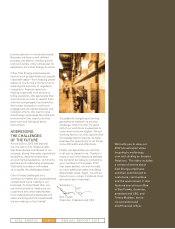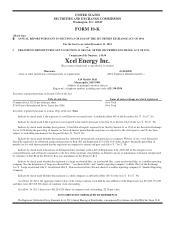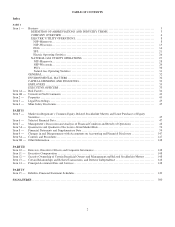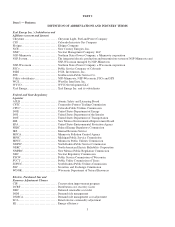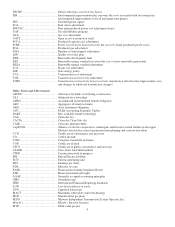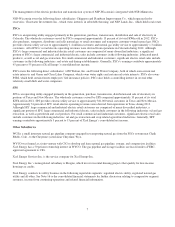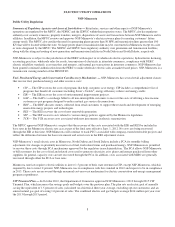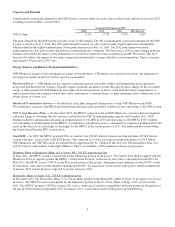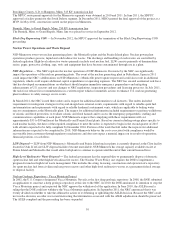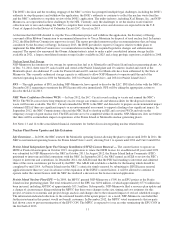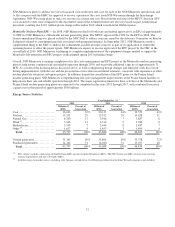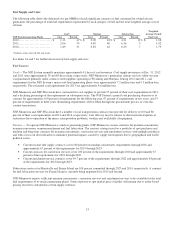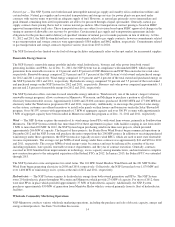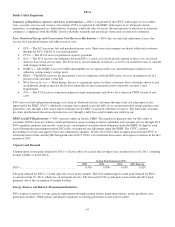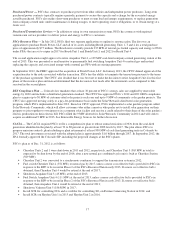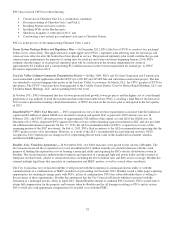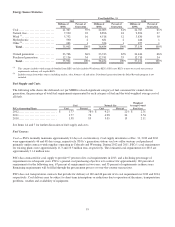Xcel Energy 2012 Annual Report Download - page 20
Download and view the complete annual report
Please find page 20 of the 2012 Xcel Energy annual report below. You can navigate through the pages in the report by either clicking on the pages listed below, or by using the keyword search tool below to find specific information within the annual report.
10
Brookings County, S.D. to Hampton, Minn. 345 KV transmission line
The MPUC route permit approvals for the Minnesota segments were obtained in 2010 and 2011. In June 2011, the SDPUC
approved a facility permit for the South Dakota segment. In December 2011, MISO granted the final approval of the project as a
MVP. In May 2012, construction started on the project in Minnesota.
Bemidji, Minn. to Grand Rapids, Minn. 230 KV transmission line
The Bemidji, Minn. to Grand Rapids, Minn. line was placed in service in September 2012.
Black Dog Repowering CON — In November 2012, the MPUC approved the termination of the Black Dog Repowering CON
proceeding.
Nuclear Power Operations and Waste Disposal
NSP-Minnesota owns two nuclear generating plants: the Monticello plant and the Prairie Island plant. Nuclear power plant
operations produce gaseous, liquid and solid radioactive wastes. The discharge and handling of such wastes are controlled by
federal regulation. High-level radioactive wastes primarily include used nuclear fuel. LLW consists primarily of demineralizer
resins, paper, protective clothing, rags, tools and equipment that have become contaminated through use in a plant.
NRC Regulation — The NRC regulates the nuclear operations of NSP-Minnesota. Decisions by the NRC can significantly
impact the operations of the nuclear generating plants. The event at the nuclear generating plant in Fukushima, Japan in 2011
could impact the NRC’s deliberations on NSP-Minnesota’s Monticello power uprate request and could also result in additional
regulation, which could require additional capital expenditures or operating expenses. The NRC has created an internal task force
that has developed recommendations on whether it should require immediate emergency preparedness and mitigating
enhancements at U.S. reactors and any changes to NRC regulations, inspection procedures and licensing processes. In July 2011,
the task force released its recommendations in a written report which recommends actions to enhance U.S. nuclear generating
plant readiness to safely manage severe events.
In March 2012, the NRC issued three orders and a request for additional information to all licensees. The orders included
requirements for mitigation strategies for beyond-design-basis external events, requirements with regard to reliable spent fuel
instrumentation and requirements with regard to reliable hardened containment vents, which are applicable to boiling water
reactor containments at the Monticello plant. The request for additional information included requirements to perform walkdowns
of seismic and flood protection, to evaluate seismic and flood hazards and to assess the emergency preparedness staffing and
communications capabilities at each plant. NSP-Minnesota expects that complying with these requirements will cost
approximately $35 to $50 million at the Monticello and Prairie Island plants. Based on current refueling outage plans specific to
each nuclear facility, the dates of the required compliance to meet the orders is expected to begin in the second quarter of 2015
with all units expected to be fully compliant by December 2016. Portions of the work that fall under the requests for additional
information are expected to be completed by 2018. NSP-Minnesota believes the costs associated with compliance would be
recoverable from customers through regulatory mechanisms and does not expect a material impact on its results of operations,
financial position, or cash flows.
LLW Disposal — LLW from NSP-Minnesota’s Monticello and Prairie Island nuclear plants is currently disposed at the Clive facility
located in Utah. If off-site LLW disposal facilities become unavailable, NSP-Minnesota has storage capacity available on-site at
Prairie Island and Monticello that would allow both plants to continue to operate until the end of their current licensed lives.
High-Level Radioactive Waste Disposal — The federal government has the responsibility to permanently dispose of domestic
spent nuclear fuel and other high-level radioactive wastes. The Nuclear Waste Policy Act requires the DOE to implement a
program for nuclear high-level waste management. This includes the siting, licensing, construction and operation of a repository
for spent nuclear fuel from civilian nuclear power reactors and other high-level radioactive wastes at a permanent federal storage
or disposal facility.
Nuclear Geologic Repository - Yucca Mountain Project
In 2002, the U.S. Congress designated Yucca Mountain, Nevada as the first deep geologic repository. In 2008, the DOE submitted
an application to construct a deep geologic repository at this site to the NRC. In 2010, the DOE announced its intention to stop the
Yucca Mountain project and requested the NRC approve the withdrawal of the application. In June 2010, the ASLB issued a
ruling that the DOE could not withdraw the Yucca Mountain application. In September 2011, the NRC announced that it was
evenly divided on whether to take the affirmative action of overturning or upholding the ASLB decision. Because the NRC could
not reach a decision, an order was issued instructing that information associated with the ASLB adjudication should be preserved.
The ASLB complied and the proceeding has been suspended.


